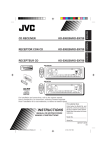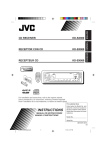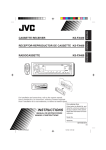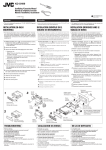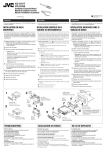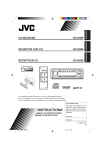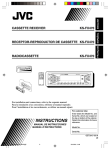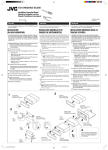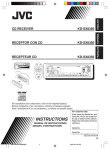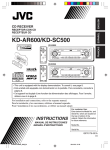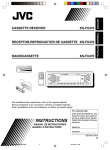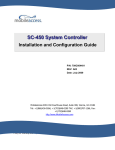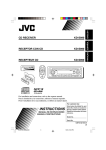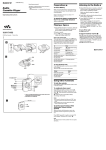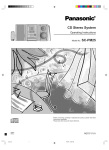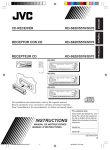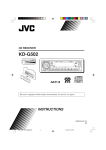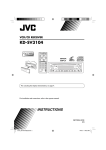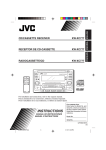Download JVC KS-FX490 Instruction Manual
Transcript
ENGLISH KS-FX490 ESPAÑOL CASSETTE RECEIVER RADIOCASSETTE FRANÇAIS RECEPTOR-REPRODUCTOR DE CASSETTE KS-FX490 KS-FX490 S For installation and connections, refer to the separate manual. Para la instalación y las conexiones, refiérase al manual separado. Pour l’installation et les raccordements, se référer au manuel séparé. For customer Use: INSTRUCTIONS MANUAL DE INSTRUCCIONES MANUEL D’INSTRUCTIONS Enter below the Model No. and Serial No. which are located on the top or bottom of the cabinet. Retain this information for future reference. Model No. Serial No. GET0120-001A [J] ENCOVER-KS-FX490[J] 3 24/2/03, 14*23 ENGLISH Thank you for purchasing a JVC product. Please read all instructions carefully before operation, to ensure your complete understanding and to obtain the best possible performance from the unit. CONTENTS How to reset your unit ....................................... How to use the MODE buttons .......................... 2 2 SOUND ADJUSTMENTS ........................ 13 LOCATION OF THE BUTTONS ................. 3 Control panel ..................................................... Preparing the remote controller ......................... Remote controller .............................................. 3 4 5 13 14 BASIC OPERATIONS ............................ 6 Turning on the power ........................................ 6 RADIO OPERATIONS ........................... 7 Listening to the radio ......................................... Storing stations in memory ................................ Tuning in to a preset station .............................. 7 8 9 TAPE OPERATIONS ............................. 10 Listening to a cassette ...................................... Finding the beginning of a tune ......................... Other convenient tape functions ....................... 10 11 12 Selecting preset sound modes (C-EQ: Custom Equalizer) .............................. Adjusting the sound ........................................... OTHER MAIN FUNCTIONS ..................... 15 Setting the clock ................................................ Changing the general settings (PSM) ............... Detaching the control panel .............................. 15 15 18 CD CHANGER OPERATIONS ................... 19 About MP3 Discs ............................................... Playing Discs ..................................................... Playing a CD Text .............................................. Selecting the playback modes .......................... 19 19 22 23 EXTERNAL COMPONENT OPERATIONS ........ 24 Playing an external component ......................... 24 MAINTENANCE .................................. 25 TROUBLESHOOTING ........................... 26 SPECIFICATIONS ................................ 28 How to reset your unit After detaching the control panel, press the reset button on the panel holder using a ballpoint pen or a similar tool. This will reset the built-in microcomputer. Note: Your preset adjustments — such as preset channels or sound adjustments — will also be erased. How to use the MODE buttons If you press MODE, the unit goes into functions mode, then the number buttons work as different function buttons. When connecting a JVC MP3-compatible CD changer. The 8/9 button will also work as +10/-10 • buttons after pressing MODE. Ex.: When number button 2 works as MO (monaural) button. MO (monaural) indicator lights up. Time countdown indicator To use these buttons for original functions again after pressing MODE, wait for 5 seconds without pressing any of these buttons untill the functions mode is cleared (“MODE” disappears from the display. • Pressing MODE again also clears the functions mode. 2 BEFORE USE *For safety.... • Do not raise the volume level too much, as this will block outside sounds, making driving dangerous. • Stop the car before performing any complicated operations. EN02-03-KS-FX490[J]-1 2 *Temperature inside the car.... If you have parked the car for a long time in hot or cold weather, wait until the temperature in the car becomes normal before operating the unit. 24/2/03, 11*45 LOCATION OF THE BUTTONS ENGLISH Control panel Display window as d h j 1 2 k 3 4 l 5 g f / z x c 6 7 7 8 200W KS-FX490 Multi Music Scan 9 p q w e 1 4 /¢ buttons 2 5 (up) button ` (tape direction) button 3 ∞ (down) button 4 Remote sensor 5 Display window 6 0 (eject) button 7 FM AM button 8 TAPE CD-CH button 9 (standby/on/attenuator) button p (control panel release) button q SEL (select) button w Control dial e MO (monaural) button r (Dolby B) button t RPT (repeat) button y RND (random) button u Number buttons i MODE button • Also functions as SSM buttons when pressed together with DISP (display) button. o DISP (display) button • Also functions as SSM buttons when pressed together with MODE button. ; EQ (equalizer) button EN02-03-KS-FX490[J]-1 3 r t yui o TAPE ; Display window a Text information indicators TAG (ID3 Tag), (folder), (track/file) • Lights up only when playing an MP3 disc or a CD Text on a JVC MP3-compatible CD changer s Tape–in indicator d Main display f Playback item indicators (disc) • Lights up only when connected to CD changer (folder) • Lights up only when playing an MP3 disc on a JVC MP3-compatible CD changer g Source/clock display h Tuner reception indicators MO (monaural), ST (stereo) j EQ (equalizer) indicator k Sound mode indicators ROCK, CLASSIC, POPS, HIP HOP, JAZZ, USER l LOUD (loudness) indicator / (Dolby B) indicator z MP3 indicator • Lights up only when playing an MP3 disc on a JVC MP3-compatible CD changer x Volume (or audio) level indicator Equalization pattern indicator c Playback mode indicators RND (random) • Lights up only when connected to CD changer RPT (repeat) 3 6/3/03, 14*05 ENGLISH Preparing the remote controller Before using the remote controller: • Aim the remote controller directly at the remote sensor on the main unit. Make sure there is no obstacle in between. 2. Place the battery. Slide the battery into the holder with the + side facing upwards so that the battery is fixed in the holder. Lithium coin battery (product number: CR2025) Remote sensor 3. Return the battery holder. Insert again the battery holder pushing it until you hear a clicking sound. • Do not expose the remote sensor to strong light (direct sunlight or artificial lighting). (back side) Installing the battery When the controllable range or effectiveness of the remote controller decreases, replace the battery. 1. Remove the battery holder. 1) Push out the battery holder in the direction indicated by the arrow using a ball-point pen or a similar tool. 2) Remove the battery holder. (back side) 1) 2) WARNING: • Store the battery in a place where children cannot reach. If a child accidentally swallows the battery, consult a doctor immediately. • Do not recharge, short, disassemble or heat the battery or dispose it in a fire. Doing any of these things may cause the battery to give off heat, crack or start a fire. • Do not leave the battery with other metallic materials. Doing this may cause the battery to give off heat, crack or start a fire. • When throwing away or saving the battery, wrap it in tape and insulate; otherwise, the battery may start to give off heat, crack or start a fire. • Do not poke the battery with tweezers or similar tools. Doing this may cause the battery to give off heat, crack or start a fire. CAUTION: DO NOT leave the remote controller in a place (such as dashboards) exposed to direct sunlight for a long time. Otherwise, it may be damaged. 4 EN04-05-KS-FX490[J]-1 4 11/2/03, 15*12 RM–RK60 • Selects the preset stations while listening to the radio. Each time you press the button, the preset station number increases, and the selected station is tuned in. While playing an MP3 disc on an MP3compatible CD changer; – Skips to the previous disc if pressed briefly. – Skips to the previous folder if pressed and held. Note: While playing a CD on a CD changer, this always skips to the previous disc. ENGLISH 3 • Remote controller 4 Selects the sound mode (C-EQ: custom equalizer). Each time you press the button, the sound mode (C-EQ) changes. S 5 Selects the source. Each time you press the button, the source changes. 6 • • 1 • • • 2 • • • Turns on the unit if pressed when the unit is turned off. Turns off the unit if pressed and held until “SEE YOU” appears on the display. Drops the volume level in a moment if pressed briefly. Press again to resume the volume. Selects the band while listening to the radio. Each time you press the button, the band changes. Changes the tape direction while listening to a cassette. Each time you press the button, the tape direction changes alternately. While playing an MP3 disc on an MP3compatible CD changer; – Skips to the next disc if pressed briefly. – Skips to the next folder if pressed and held. Note: While playing a CD on a CD changer, this always skips to the next disc. • • • 7 Searches for stations while listening to the radio. Functions as the fast-forward or rewind buttons if pressed and hold while listening to a cassette. To release this operation, press button 2 to resume playback. Functions as Multi Music Scan buttons if pressed while listening to a cassette. To release this operation, press button 2 to resume playback. Fast-forwards or reverses the track/file if pressed and held while listening to the CD changer. Skips to the beginning of the next track/file or goes back to the beginning of the current (or previous) tracks/files if pressed briefly while listening to the CD changer. Functions the same as the control dial on the main unit. Note: These buttons do not function for the preferred setting mode adjustment. 5 EN04-05-KS-FX490[J]-1 5 11/2/03, 15*12 ENGLISH BASIC OPERATIONS 1 3 3 Turning on the power 1 2 Adjust the volume. To increase the volume. Turn on the power. “HELLO” appears on the display. To decrease the volume. Volume level appears. Note on One-Touch Operation: When you select a source in step 2 below, the power automatically comes on. You do not have to press this button to turn on the power. 2 Select the source. FM1 TAPE Volume or audio level (see page 17) indicator FM2 AM FM3 CD * TAPE (or LINE IN ** ) To operate the tuner (FM or AM), see pages 7 – 9. To operate the tape, see pages 10 – 12. To operate the CD changer, see pages 19 – 23. To operate the external component, see page 24. Notes: * Without connecting the CD changer you cannot select the CD changer as the source. ** To select the external component other than the CD Changer, the “EXT IN” setting must be set to LINE IN. (See page 17.) 4 Adjust the sound as you want. (See pages 13 – 14.) To drop the volume in a moment Press briefly while listening to any source. “ATT” starts flashing on the display, and the volume level will drop in a moment. To resume the previous volume level, press the button briefly again. • If you turn the control dial, you can also restore the sound. To turn off the power Press and hold on the display. until “SEE YOU” appears Note: When you use this unit for the first time, set the built-in clock correctly, see page 15. 6 EN06-06-KS-FX490[J]-1 6 17/3/03, 9*11 ENGLISH RADIO OPERATIONS To stop searching before a station is received, press the same button you have pressed for searching. Listening to the radio You can use either automatic searching or manual searching to tune in to a particular station. Searching a station automatically: Auto search 1 1 Select the band (FM1 – 3, AM). FM1 FM2 FM3 (F1) (F2) (F3) Searching a station manually: Manual search AM Selected band appears. Note: This receiver has three FM bands (FM1, FM2, FM3). You can use any one of them to listen to an FM broadcast. 2 Select the band (FM1 – 3, AM). FM1 FM2 FM3 (F1) (F2) (F3) AM Note: This receiver has three FM bands (FM1, FM2, FM3). You can use any one of them to listen to an FM broadcast. 2 Press and hold ¢ or 4 until “MANU (manual)” starts flashing on the display. Start searching a station. Press ¢ to search stations of higher frequencies. Selected band appears. to search Press 4 stations of lower frequencies. While searching stations, “SEEK” appears on the display. When a station is received, searching stops. EN07-09-KS-FX490[J]-1 7 CONTINUED ON THE NEXT PAGE 7 11/2/03, 16*34 ENGLISH 3 Tune in to a station you want while “MANU (manual)” is flashing. Press ¢ to tune in to stations of higher frequencies. to tune Press 4 in to stations of lower frequencies. • If you release your finger from the button, the manual mode will automatically turn off after 5 seconds. • If you hold down the button, the frequency keeps changing. (in 200 kHz intervals for FM and 10 kHz for AM) until you release the button. Storing stations in memory You can use one of the following two methods to store broadcasting stations in memory. • Automatic preset of FM stations: SSM (Strongstation Sequential Memory) • Manual preset of both FM and AM stations FM station automatic preset: SSM You can preset 6 local FM stations in each FM band (FM1, FM2 and FM3). 1 Each time you press the button, the band changes as follows: When an FM stereo broadcast is hard to receive: 1 Press MODE to enter the functions mode while listening to an FM stereo broadcast. “MODE” flashes on the upper part of the display, and the number buttons work as different function buttons. Select the FM band (FM1 – 3) you want to store FM stations into. 2 FM1 FM2 FM3 (F1) (F2) (F3) AM Press and hold both buttons for more than 2 seconds. 2 Press MO (monaural), while “MODE” is still on the display, so that the MO indicator lights up on the display. Then, each time you press MO (monaural), the MO indicator lights up and goes off alternately. Lights up when receiving an FM broadcast in stereo. “SSM” appears, then disappears when automatic preset is over. Local FM stations with the strongest signals are searched and stored automatically in the band number you have selected (FM1, FM2 or FM3). These stations are preset in the number buttons — No.1 (lowest frequency) to No.6 (highest frequency). When automatic preset is over, the station stored in number button 1 will be automatically tuned in. When the MO indicator is lit on the display, the sound you hear becomes monaural but the reception will be improved. 8 EN07-09-KS-FX490[J]-1 8 24/2/03, 11*57 You can preset up to 6 stations in each band (FM1, FM2, FM3 and AM) manually. Ex.: Storing an FM station of 88.3 MHz into the preset number 1 of the FM1 band 1 Select the band (FM1 – 3, AM) you want to store stations into (in this example, FM1). Each time you press the button, the band changes as follows: 2 FM1 FM2 FM3 (F1) (F2) (F3) Notes: • A previously preset station is erased when a new station is stored in the same preset number. • Preset stations are erased when the power supply to the memory circuit is interrupted (for example, during battery replacement). If this occurs, preset the stations again. Tuning in to a preset station AM Tune in to a station (in this example, of 88.3 MHz). Press ¢ to tune in to stations of higher frequencies. You can easily tune in to a preset station. Remember that you must store stations first. If you have not stored them yet, see “Storing stations in memory” on pages 8 and 9. 1 Press 4 to tune in to stations of lower frequencies. 2 3 Repeat the above procedure to store other stations into other preset numbers. ENGLISH 4 Manual preset Select the band (FM1 – 3, AM). FM1 FM2 FM3 (F1) (F2) (F3) AM Select the number (1 – 6) for the preset station you want. Press and hold the number button (in this example, 1) for more than 2 seconds. Note: You can also use the 5 (up) or ∞ (down) buttons on the unit to select the next or previous preset stations. Each time you press the 5 (up) or ∞ (down) buttons, the next or previous preset station is tuned in. Selected band/preset number and “MEMO” (memory) appear alternately for a while. 9 EN07-09-KS-FX490[J]-1 9 11/2/03, 16*34 ENGLISH TAPE OPERATIONS Listening to a cassette You can play back type I (normal) tapes. 1 Open the control panel. Note on One-Touch Operation: When a cassette is already in the cassette compartment, select tape as the source by pressing TAPE CD-CH to start tape play automatically. 2 Insert a cassette into the cassette compartment. The unit turns on and tape play starts automatically. 3 Close the control panel by hand. Tape–in indicator appears. 4 Select the tape direction. 10 EN10-12-KS-FX490[J]-1 Each time you press `, the tape direction changes alternately forward (TAPE ) and reverse (TAPE ). 10 To stop play and eject the cassette Press 0. Tape play stops, the control panel opens and then the cassette automatically ejects from the cassette compartment. The source changes to the previously selected one. If you change the source, tape play also stops (without ejecting the cassette this time). • You can eject the cassette while the unit is turned off by pressing 0. To fast-forward and rewind a tape Press ¢ for more than 1 second to fast-forward the tape. When the tape reaches its end, the tape is reversed and playback starts from the beginning of the other side. Press 4 for more than 1 second to rewind the tape. When the tape reaches its end, playback of the same side starts. To stop fast forward and rewind at any position on the tape, press `. Tape play starts from that position on the tape. Notes: • When one side of the tape reaches its end during play, the other side of the tape automatically starts playing. (Auto Reverse) • When the tape reaches its end while fast-forwarding, the tape direction will be changed automatically. 11/2/03, 15*13 Finding the beginning of a tune 1 Press MODE to enter the functions mode Multi Music Scan allows you to automatically start playback from the beginning of a specified tune. You can specify up to 9 tunes ahead of or before the current tune. while listening to a tape. “MODE” flashes on the upper part of the display, and the number buttons work as different function buttons. 2 Press (Dolby B), while “MODE” is still on the display so that the (Dolby B) indicator lights up. “DOLBY B” also appears on the display for several seconds. ENGLISH To play back tapes recorded with the Dolby B NR* During playback Specify where (how many tunes ahead of or before the current tune) the tune you want is located. To cancel the Dolby B NR, repeat steps 1 and 2 above again. Press ¢ to locate a tune ahead of the current tune on the cassette. * Manufactured under license from Dolby Laboratories. “Dolby” and the double-D symbol are trademarks of Dolby Laboratories. Press 4 to locate a tune before the current tune on the cassette. Prohibiting cassette ejection You can prohibit cassette ejection and lock a cassette in the cassette compartment. While pressing TAPE (CD-CH), press and hold for more than 2 seconds. TAPE “NO EJECT” flashes on the display for about 5 seconds, and the cassette is locked and cannot be ejected. To cancel the prohibition and unlock the cassette While pressing TAPE (CD-CH), press and hold again for more than 2 seconds. “EJECT OK” flashes on the display for about 5 seconds, and the cassette is unlocked. Note: Each time you press the buttons, the number changes up to ±9. When the beginning of the specified tune is located, playback starts automatically. Notes: • While locating a specified tune: – If the tape is rewound to its beginning, playback starts from the beginning of that side. – If the tape is fast-forwarded to the end, it is reversed and played from the beginning of the other side. • In the following cases, the Multi Music Scan function may not operate correctly: – Tapes with tunes having long pianissimo passages (very quiet parts) or non-recorded portions between tunes. – Tapes with short non-recorded sections. – Tapes with high level of noise or humming between tunes. – Tapes with tunes recorded at low recording levels. – The Dolby NR setting does not match. For example, if Dolby B NR is on and the tape was recorded with no Dolby NR. If you press c while cassette ejection is prohibited, the cassette will not be ejected. EN10-12-KS-FX490[J]-1 11 11 24/2/03, 11*58 ENGLISH Other convenient tape functions Playing the current tune repeatedly Skipping the blank portions on the tape You can play the current tune repeatedly (Repeat Play). You can skip blank portions between the tunes (Blank Skip). When this function is on, the unit skips blank portions of 15 seconds or more, fast-forwards to the next tune, then starts playing it. • See also “Changing the general settings (PSM)” on pages 15 and 16. 1 Press and hold SEL (select) for more than 2 seconds so that one of the PSM items appears on the display. (PSM: see page 16.) 1 Press MODE to enter the functions mode while playing a tune you want to hear over again on a cassette. “MODE” flashes on the upper part of the display, and the number buttons work as different function buttons. 2 Press RPT (repeat), while “MODE” is still on the display, so that the RPT indicator lights up on the display. Lights up when Repeat Play is turned on. 2 Press ¢ or 4 to select “B. SKIP (blank skip).” When the tune has been played, the tape is automatically rewound to the beginning of that tune and the same tune will be played again. To cancel Repeat Play, repeat steps 1 and 2 above again so that the RPT indicator goes off. 3 Turn the control dial clockwise to select “ON.” Now Blank Skip is activated. 4 Finish the setting. Note: In the following cases, Blank Skip and Repeat Play may not operate correctly: – Tapes with tunes having long pianissimo passages (very quiet parts) or non-recorded portions during tunes. – Tapes with short non-recorded sections. – Tapes with high level noise or humming between tunes. – Tapes with tunes recorded at low recording levels. – The Dolby NR setting does not match. For example, if Dolby B NR is on and the tape was recorded with no Dolby NR. To cancel Blank Skip, repeat the same procedure and select “OFF” in step 3 by turning the control dial counterclockwise. 12 EN10-12-KS-FX490[J]-1 12 24/2/03, 12*00 Selecting preset sound modes (C-EQ: Custom Equalizer) You can select a preset sound mode (C-EQ: custom equalizer) suitable to the music genre. Select the sound mode you want. When you press the button once, the last selected sound mode is recalled and applied to the current source. Sound mode indicator flashes Indication USER ROCK CLASSIC POPS HIP HOP JAZZ For: (Flat sound) Rock or disco music Classical music Light music Funk or Rap music Jazz music BAS 00 +03 Preset values TRE LOUD 00 OFF +01 ON +01 –02 OFF +04 +02 +01 00 OFF ON +02 +03 OFF ENGLISH SOUND ADJUSTMENTS Note: • You can adjust each sound mode to your preference. Once you make an adjustment, it is automatically stored for the currently selected sound mode. See “Adjusting the sound” on page 14. Ex.: If you have selected “USER” previously Then, each time you press the button, the sound modes change as follows: USER JAZZ ROCK CLASSIC POPS HIP HOP Sound mode indicator flashes. Ex.: When you select “ROCK” 13 EN13-14-KS-FX490[J]-1 13 11/2/03, 15*13 ENGLISH Adjusting the sound 2 Adjust the level. You can adjust the sound characteristics to your preference. To increase the level or turn on the loudness. 1 To decrease the level or turn off the loudness. Select the item you want to adjust. Each time you press the button, the adjustable items change as follows: BAS (bass) VOL (volume) TRE (treble) LOUD (loudness) FAD (fader) BAL (balance) Indication To do: Range BAS*1 Adjust the bass. –06 (min.) | +06 (max.) TRE*1 Adjust the treble. –06 (min.) | +06 (max.) FAD*2 Adjust the front and rear speaker balance. R06 (Rear only) | F06 (Front only) BAL Adjust the left and right speaker balance. L06 (Left only) | R06 (Right only) LOUD*1 Boost low and high frequencies to produce a wellbalanced sound at low volume level. VOL*3 Equalization pattern changes as you adjust the bass or treble. LOUD ON | Ex. 1: When you adjust “TRE” (treble) Ex. 2: When you turn on the loudness 3 Repeat steps 1 and 2 to adjust the other items. To reset each sound mode to the factory settings, repeat the same procedure and reassign the preset values listed in the table on page 13. LOUD OFF Adjust the volume. 00 (min.) | 50 (max.) *1 When you adjust the bass, treble, or loudness, the adjustment you have made is stored for the currently selected sound mode (C-EQ) including “USER.” *2 If you are using a two-speaker system, set the fader level to “00.” *3 Normally the control dial works as the volume control. So you do not have to select “VOL” to adjust the volume level. 14 EN13-14-KS-FX490[J]-1 14 24/2/03, 14*27 Changing the general settings (PSM) Setting the clock 1 Press and hold SEL (select) for more than 2 seconds so that one of the PSM items appears on the display. (See page 16.) You can change the items listed on the next page by using the PSM (Preferred Setting Mode) control. ENGLISH OTHER MAIN FUNCTIONS Basic Procedure 1 2 Press and hold SEL (select) for more than 2 seconds so that one of the PSM items appears on the display. (See page 16.) Set the hour. 1 Select “CLOCK H (hour)” if not shown on the display. 2 Adjust the hour. 1 3 2 Set the minute. 1 Select “CLOCK M (minute).” 2 Adjust the minute. 1 2 3 Adjust the PSM item selected. 2 4 4 Select the PSM item you want to adjust. (See page 16.) Repeat steps 2 and 3 to adjust the other PSM items if necessary. Finish the setting. 5 Finish the setting. 15 EN15-18-KS-FX490[J]-1 15 19/2/03, 15*41 ENGLISH Preferred Setting Mode (PSM) items 1 2 3 Set. Hold. Select. Counterclockwise Factory-preset settings See page 1:00 15 ON 16 AUDIO 2 17 OFF 12 ONCE 17 Clockwise CLOCK H Hour adjustment Back Advance CLOCK M Minute adjustment Back Advance CLOCK Clock OFF ON LEVEL Level display AUDIO 2 AUDIO 1 OFF B. SKIP Blank skip SCROLL Scroll mode OFF ON AUTO ONCE OFF • EXT IN* External component TAG DISP Tag display CHANGER LINE IN CHANGER 17 TAG OFF TAG ON TAG ON 17 Press SEL (select) to finish the setting. * Displayed only when one of the following sources is selected – FM, AM and TAPE. To set the clock display—CLOCK When CLOCK is set to OFF: You can set the clock to be shown on the display when the unit is turned on. When shipped from the factory, the clock is set to be shown on the display. Source • ON: • OFF: Clock display is turned on. Clock display is turned off. When “OFF” is selected, the current source name, station band, or disc number appears instead of the clock display (except when “LINE IN” is selected as the source). Current indication Tuner Band TAPE and CD-CH “TAPE” or disc number Source Tuner Current indication Clock Clock 16 16 Clock appears for about 5 seconds When CLOCK is set to ON: TAPE and CD-CH EN15-18-KS-FX490[J]-1 Pressing DISP 6/3/03, 13*08 Pressing DISP Band appears for about 5 seconds. “TAPE” or disc number and track/file number appear alternately each time you press the button You can select the level display according to your preference. When shipped from the factory, “AUDIO 2” is selected. • AUDIO 1: • AUDIO 2: • OFF: Shows the audio level indicator. Alternates between “AUDIO 1” setting and illumination display. Erases the audio level indicator. To select the scroll mode—SCROLL You can select the scroll mode for the disc information (when the entire text cannot be shown all at once). When shipped from the factory, scroll mode is set to “ONCE.” • ONCE: • AUTO: • OFF: To turn the tag display on or off —TAG DISP This function takes effect only when JVC MP3-compatible CD changer is connected. An MP3 file can contain file information called “ID3 Tag” where its album name, performer, track title, etc. are recorded. There are two versions–ID3v1 (ID3 Tag version 1) and ID3v2 (ID3 Tag version 2). Only ID3v1 can be shown. When shipped from the factory, “TAG ON” is selected. • TAG ON: Scrolls only once. Repeats the scroll (5-second intervals in between). Cancels scroll mode. Note: Even if the scroll mode is set to “OFF,” you can scroll the display by pressing DISP (display) for more than one second. To select the external component to use – EXT IN ENGLISH To select the level meter – LEVEL Turns on the ID3 tag display while playing MP3 files. • If an MP3 file does not have ID3 tags, folder name and file name appear. Note: If you change the setting from “TAG OFF” to “TAG ON” while playing an MP3 file, the tag display will be activated when the next file starts playing. • TAG OFF: Turns off the ID3 tag display while playing MP3 files. (Only the folder name and file name can be shown.) You can connect the external component to the CD changer jack on the rear using the Line Input Adaptor KS-U57 (not supplied). To use the external component as the playback source through this unit, you need to select which component – CD changer or external component – to use. When shipped from the factory, CD changer is selected as the external component. • LINE IN: To use the external component other than CD changer. • CHANGER: To use the CD changer. Note: For connecting the Line Input Adaptor KS-U57 and the external component, refer to the Installation/Connection Manual (separate volume). 17 EN15-18-KS-FX490[J]-1 17 5/3/03, 10*44 ENGLISH Detaching the control panel You can detach the control panel when leaving the car. When detaching or attaching the control panel, be careful not to damage the connectors on the back of the control panel and on the panel holder. Attaching the control panel 1 Insert the right side of the control panel into the groove on the panel holder. Detaching the control panel Before detaching the control panel, be sure to turn off the power. 1 Unlock the control panel. 2 Pull the control panel out of the unit. 3 2 Press the left side of the control panel to fix it to the panel holder. Note on cleaning the connectors: If you frequently detach the control panel, the connectors will deteriorate. To minimize this possibility, periodically wipe the connectors with a cotton swab or cloth moistened with alcohol, being careful not to damage the connectors. Put the detached control panel into the provided case. Connectors 18 EN15-18-KS-FX490[J]-1 18 18/2/03, 20*02 ENGLISH CD CHANGER OPERATIONS We recommend that you use the JVC MP3compatible CD changer with your unit. By using this CD changer, you can play back your original CD-Rs (Recordable) and CD-RWs (Rewritable) recorded either in audio CD format or in MP3 format. • You can also connect other CH-X series CD changers (except CH-X99 and CH-X100). However, they are not compatible with MP3 discs, so you cannot play back MP3 discs. • You cannot use the KD-MK series CD changers with this unit. Before operating your CD changer: • Refer also to the Instructions supplied with your CD changer. • If no discs are in the magazine of the CD changer or the discs are inserted upside down, “NO DISC” will appear on the display. If this happens, remove the magazine and set the discs correctly. • If no magazine is loaded in the CD changer, “NO MAG” appears on the display. If this happens, insert the magazine in the CD changer. • If “RESET 1” – “RESET 8” appears on the display, something is wrong with the connection between this unit and the CD changer. If this happens, check the connection and make sure the cords are connected firmly. Then, press the reset button of the CD changer. About MP3 discs MP3 “files (tracks)” can be recorded in “folders” —in PC terminology. During recording, the files and folders can be arranged in a way similar to arranging files and folders of computer data. “Root” is similar to the root of a tree. Every file and folder can be linked to and be accessed from the root. Playing discs Select the CD changer (CD-CH). TAPE CD * TAPE (or LINE IN) * If you have changed “EXT IN” setting to “LINE IN” (see page 17), you cannot select the CD changer. 19 EN19-23-KS-FX490[J]-1 19 24/2/03, 12*20 ENGLISH • When the current disc is an MP3 disc: Playback starts from the first folder of the current disc once file check is completed. Selected disc number** * When “CLOCK” is set to “ON” (see page 16), the current indication will soon change to the clock time. Notes: • When you press TAPE (CD-CH), the power automatically comes on. You do not have to press to turn on the power. • If you change the source, CD changer play also stops. Next time you select the CD changer as the source, CD changer play starts from where playback has been stopped previously. • When you start playing back a CD Text or MP3 disc, disc information will automatically appear on the display. (See pages 22.) To go to a particular disc directly Press the number button corresponding to the disc number to start its playback (while the CD changer is playing). (folder) indicator MP3 indicator ** When “CLOCK” is set to “ON” (see page 16), the current indication will soon change to the clock time. Note: Folder name appears on the display instead of “ROOT,” if an MP3 disc contains a folder. • When the current disc is a CD: Playback starts from the first track of the current disc. • To select a disc number from 1 – 6: Press 1 (7) – 6 (12) briefly. • To select a disc number from 7 – 12: Press and hold 1 (7) – 6 (12) for more than one second. To fast-forward or reverse the track/file Press and hold ¢ , during play, to fast-forward the track/file. Press and hold 4 , during play, to reverse the track/file. To go to the next or previous tracks/files Elapsed playing time Current track number Press ¢ briefly during play, to skip ahead to the beginning of the next track/file. Each time you press the button consecutively, the beginning of the next tracks/files is located and played back. Press 4 briefly during play, to skip back to the beginning of the current track/file. Each time you press the button consecutively, the beginning of the previous tracks/files is located and played back. 20 EN19-23-KS-FX490[J]-1 20 24/2/03, 12*20 To go to a track/file quickly 1 Press MODE to enter the functions mode while playing a disc. “MODE” flashes on the upper part of the display. 2 Press 8 (up) or 9 (down) To skip 10 tracks/files* forwards to the last track/file To skip 10 tracks/files* backwards to the first track/file * The first time you press 8 (up) or 9 (down) button, the track/file skips to the nearest higher or lower track/file with a track/file number of multiple ten (ex. 10th, 20th, 30th). Then, each time you press the button, you can skip 10 tracks/files (see “How to go to the desired track/file quickly”). • After the last track/file, the first track/file will be selected, and vice versa. To skip to the next or previous folder (only for MP3 discs) Press 5 (up) while playing an MP3 disc, to go to the next folder. Each time you press the button consecutively, the next folder is located, and the first file in the folder starts playback. ENGLISH This operation is only possible when using JVC MP3-compatible CD changer (CH-X1500). Press ∞ (down) while playing an MP3 disc, to go to the previous folder. Each time you press the button consecutively, the previous folder is located, and the first file in the folder starts playback. To show the disc information for CD Text and MP3 discs This is possible only when connecting a JVC CD changer equipped with CD Text and/or MP3 disc information reading capability. Select text display mode while playing a CD Text or an MP3 disc. • For details, see page 22 about CD Text disc information and MP3 disc information. Note: If the current playing disc is an MP3 disc, files are skipped within the same folder. How to go to the desired track/file quickly • Ex. 1: To select track/file number 32 while playing track/file number 6 (Three times) (Twice) Track/File 6 \ 10 \ 20 \ 30 \ 31 \ 32 • Ex. 2: To select track/file number 8 while playing track/file number 36 (Three times) (Twice) Track/File 36 \ 30 \ 20 \ 10 \ 9 \ 8 21 EN19-23-KS-FX490[J]-1 21 24/2/03, 12*20 ENGLISH Playing a CD Text To change the display information In a CD Text, some information about the disc (its disc title, performer, and track title) is recorded. This CD Text information will be shown automatically when you play a CD Text. To change the CD Text information manually, select text display mode while playing a CD Text. Each time you press the button, the display changes as follows: Disc title / performer ( While playing back an MP3 file, you can change MP3 disc information shown on the display. Each time you press DISP (display), the display changes to show the following: • When “TAG DISP” is set to “TAG ON” (initial setting: see page 17) Album name / performer (folder name*) (TAG lights up on the display) Track title (file name*) (TAG lights up on the display) Track title lights up on the display) Elapsed playing time and Current track number Notes: • The display shows up to 8 characters at a time and scrolls if there are more than 8 characters. See also “To select the scroll mode—SCROLL” on page 17. Some characters or symbols will not be shown (and be blanked) on the display. (Ex. “ABCå!d#” ]“ABCA D ”) • When you press DISP (display) while playing a conventional CD, “NO NAME” appears for the disc title/performer and the track title. Elapsed playing time and Current file number * If an MP3 file does not have ID3 tags, folder name and file name appear. In this case, the TAG indicator will not lights up on the display. • When “TAG DISP” is set to “TAG OFF” ( Folder name lights up on the display) ( File name lights up on the display) Elapsed playing time and Current file number Note: The display shows up to 8 characters at a time and scrolls if there are more than 8 characters. See also “To select the scroll mode—SCROLL” on page 17. 22 EN19-23-KS-FX490[J]-1 22 24/2/03, 12*20 To play back tracks/files at random (Folder Random/Disc Random/Magazine Random Play) To play back tracks/files repeatedly (Track Repeat/Folder Repeat/Disc Repeat Play) 1 Press MODE to enter the functions mode during play. “MODE” flashes on the upper part of the display. 1 Press MODE to enter the functions mode during play. “MODE” flashes on the upper part of the display. 2 Press RPT (repeat), while “MODE” is still flashing on the display. Each time you press the button, the repeat play mode changes as follows: 2 Press RND (random), while “MODE” is still flashing on the display. Each time you press the button, the random play mode changes as follows: For MP3 discs: For MP3 discs: FLDR RND DISC RND Canceled MAG RND DISC RND MAG RND ENGLISH Selecting the playback modes TRK RPT FLDR RPT Canceled DISC RPT TRK RPT DISC RPT For CDs: Canceled For CDs: Canceled (disc) and RPT indicators RND indicator Ex.: When you select “MAG RND” Note: MP3 indicator also lights up if the current playing disc is an MP3 disc. Ex.: When you select “DISC RPT” Note: MP3 indicator also lights up if the current playing disc is an MP3 disc. Mode Mode FLDR RND* DISC RND MAG RND Active indicator Plays at random Active indicator Plays repeatedly TRK RPT and RND All files of the indicators current folder, then light up. files of the next folder and so on. RPT indicator The current (or lights up. specified) track/file. FLDR RPT* and RND All tracks/files of the indicators current (or specified) light up. disc. and RPT All files of the indicators current (or specified) light up. folder of the current disc. DISC RPT and RPT All tracks/files of the indicators current (or specified) light up. disc. RND indicator All tracks/files of the lights up. inserted discs. * “FLDR RPT” is only applicable for MP3 disc. * “FLDR RND” is only applicable for MP3 disc. 23 EN19-23-KS-FX490[J]-1 23 24/2/03, 12*20 ENGLISH EXTERNAL COMPONENT OPERATIONS Playing an external component 2 You can connect the external component to the CD changer jack on the rear using the Line Input Adaptor KS-U57 (not supplied). 3 Preparations: • For connecting the Line Input Adaptor KS-U57 and the external component, refer to the Installation/ Connection Manual (separate volume). • Before operating the external component using the following procedure, select the external input correctly. (See “To select the external component to use – EXT IN” on page 17.) 1 4 Turn on the connected component and start playing the source. Adjust the volume. Adjust the sound characteristics you want. (See pages 13 – 14.) Select the external component (LINE IN). TAPE LINE IN (or CD) TAPE • If “LINE IN” does not appear on the display, see page 17 and select the external input (“LINE IN”). • Displayed only when one of the following sources is selected – FM, AM and TAPE. Note on One-Touch Operation: When you press TAPE CD-CH, the power automatically comes on. You do not have to press to turn on the power. 24 EN24-24-KS-FX490[J]-1 24 6/3/03, 13*09 This unit requires very little attention, but you will be able to extend the life of the unit if you follow the instructions below. To clean the head CAUTION: • Do not play the cassettes with peeling labels; otherwise, they can damage the unit. • Tighten tapes to remove slack since loose tape may become entangled with the mechanism. • Do not leave a cassette in the cassette compartment after use, as the tape may become slack. ENGLISH MAINTENANCE The function below is also provided to ensure the longer life of this unit. Ignition key-off release/Ignition key-on play • Clean the heads after every 10 hours of use using a wet-type head cleaning tape (available at an audio store). When the head becomes dirty, you may realize the following symptoms: – Sound quality is reduced. – Sound level decreases. – Sound drops out. • Do not play dirty or dusty tapes. • Do not touch the highly-polished head with any metallic or magnetic tools. • Turning off the ignition key with a cassette in the compartment automatically releases the tape from the unit’s tapehead. • Turning on the ignition key with a cassette in the compartment starts playback automatically if you turned off the ignition during tape play. To keep the tape clean • Always store the cassettes in their storage cases after use. • Do not store cassettes in the following places: – Subject to direct sunlight – With high humidity – At extremely hot temperatures 25 EN25-27-KS-FX490[J]-1 25 11/2/03, 15*15 What appears to be trouble is not always serious. Check the following points before calling a service center. Symptoms Causes • Sound cannot be heard from the speakers. Tape Playback FM/AM General ENGLISH TROUBLESHOOTING Remedies The volume level is set to the minimum level. Adjust it to the optimum level. Connections are incorrect. Check the cords and connections. • This unit does not work at all. The built-in microcomputer may have functioned incorrectly due to noise, etc. Press the reset button on the panel holder after detaching the control panel. (The clock setting and preset stations stored in memory are erased.) (See page 2.) • SSM (Strong-station Sequential Memory) automatic preset does not work. Signals are too weak. Store stations manually. • Static noise while listening to the radio. The antenna is not connected firmly. Connect the antenna firmly. • A cassette tape cannot be ejected. Cassette is locked. Unlock the cassette. (See page 11.) • A cassette tape cannot be inserted. You have tried to insert a cassette in the wrong way. Insert the cassette with the exposed tape facing right. • Cassette tapes become hot. This is not a malfunction. • Tape sound is at very low level and sound quality is degraded. The tape head is dirty. Clean it with a head cleaning tape. 26 EN25-28-KS-FX490[J]-1 26 11/2/03, 17*06 Remedies No disc is in the magazine. Insert discs into the magazine. Discs are inserted upside down. Insert discs correctly. Discs are unplayable. Insert playable discs. • NO MAG appears on the display. No magazine is loaded in the CD changer. Insert the magazine. • NO FILES flashes on the display. The current disc does not contain any MP3 files. Insert a disc that contains MP3 files. • MP3 disc is skipped or cannot be played back. MP3 files do not have the extension code — mp3 in their file names. Add the extension code — mp3 to their file names. MP3 files are not recorded in the format compliant with ISO 9660 Level 1, Level 2, or Joliet. Change the disc. (Record MP3 files using a compliant application.) • Noise is generated while playing an MP3 disc. The file played back is not an MP3 file (although it has the extension code — mp3). Skip to another file or change the disc. (Do not add the extension code — mp3 to nonMP3 files.) • A longer readout time is required for an MP3 disc ( CHECK keeps flashing on the display). Readout time varies due to the complexity of the folder/file configuration. Do not use too many hierarchies and folders. Also, do not record any other types of audio tracks together with MP3 files. • MP3 files cannot be played back as you have intended them to play. Playback order is determined when the files are recorded. • Elapsed playing time is not correct for an MP3 disc. This sometimes occurs during play. This is caused by how the files are recorded on the disc. • RESET 8 appears on the display. This unit is not connected to the CD changer correctly. • RESET 1 RESET 7 appears on the display. • The CD changer does not work at all. ENGLISH • NO DISC appears on the display. Causes CD Changer Symptoms Connect this unit and the CD changer correctly and press the reset button of the CD changer. Press the reset button of the CD changer. The built-in microcomputer may have function incorrectly due to noise, etc. Press the reset button on the panel holder after detaching the control panel. (The clock setting and preset stations stored in memory are erased.) (See page 2.) 27 EN25-28-KS-FX490[J]-1 27 19/2/03, 13*30 ENGLISH SPECIFICATIONS AUDIO AMPLIFIER SECTION CASSETTE DECK SECTION Maximum Power Output: Front: 50 W per channel Rear: 50 W per channel Continuous Power Output (RMS): Front: 19 W per channel into 4 Ω, 40 Hz to 20 000 Hz at no more than 0.8 % total harmonic distortion. Rear: 19 W per channel into 4 Ω, 40 Hz to 20 000 Hz at no more than 0.8 % total harmonic distortion. Load Impedance: 4 Ω (4 Ω to 8 Ω allowance) Tone Control Range: Bass: ±10 dB at 100 Hz Treble: ±9 dB at 10 kHz Frequency Response: 40 Hz to 20 000 Hz Signal-to-Noise Ratio: 70 dB Line-Out Level/Impedance: 2.0 V/20 kΩ load (250 nWb/m) Wow & Flutter: 0.11% (WRMS) Fast-Wind Time: 100 sec. (C-60) Frequency Response (Dolby B NR OFF): 30 Hz to 16 000 Hz (Normal tape) Signal-to-Noise Ratio: (Normal tape) (Dolby B NR ON): 65 dB (Dolby B NR OFF): 56 dB Stereo Separation: 40 dB TUNER SECTION Frequency Range: FM: 87.5 MHz to 107.9 MHz AM: 530 kHz to 1 710 kHz [FM Tuner] Usable Sensitivity: 11.3 dBf (1.0 µV/75 Ω) 50 dB Quieting Sensitivity: 16.3 dBf (1.8 µV/75 Ω) Alternate Channel Selectivity (400 kHz): 65 dB Frequency Response: 40 Hz to 15 000 Hz Stereo Separation: 35 dB Capture Ratio: 1.5 dB [AM Tuner] Sensitivity: 20 µV Selectivity: 35 dB GENERAL Power Requirement: Operating Voltage: DC 14.4 V (11 V to 16 V allowance) Grounding System: Negative ground Allowable Operating Temperature: 0°C to +40°C (32°F to 104°F) Dimensions (W x H x D): Installation Size: 182 mm x 52 mm x 150 mm (7-3/16" x 2-1/16" x 5-15/16") Panel Size: 188 mm x 58 mm x 12 mm (7-7/16" x 2-5/16" x 1/2") Mass: 1.3 kg (2.9 lbs) (excluding accessories) Design and specifications are subject to change without notice. If a kit is necessary for your car, consult your telephone directory for the nearest car audio speciality shop. 28 EN25-28-KS-FX490[J]-1 28 5/3/03, 10*44 http://www.jvcmobile.com Visit us on-line for Technical Support & Customer Satisfaction Survey. US RESIDENTS ONLY Having TROUBLE with operation? Please reset your unit Refer to page of How to Reset Still having trouble?? USA ONLY Call 1-800-252-5722 http://www.jvc.com We can help you! VICTOR COMPANY OF JAPAN, LIMITED V EN, SP, FR J C 0303KKSFLEJEIN © 2002 VICTOR COMPANY OF JAPAN, LIMITED ENCOVER-KS-FX490[J] 2 11/2/03, 15*20 KS-FX490 Installation/Connection Manual Manual de instalación/conexión Manuel d’installation/raccordement V GET0120-002A J C 0303KKSFLEJEIN EN, SP, FR [J] ENGLISH ESPAÑOL FRANÇAIS • This unit is designed to operate on 12 V DC, NEGATIVE ground electrical systems. • Esta unidad está diseñada para funcionar con 12 V de CC, con sistemas eléctricos de masa NEGATIVA. • Cet appareil est conçu pour fonctionner sur des sources de courant continu de 12 V à masse NEGATIVE. INSTALLATION (IN-DASH MOUNTING) INSTALACION (MONTAJE EN EL TABLERO DE INSTRUMENTOS) INSTALLATION (MONTAGE DANS LE TABLEAU DE BORD) • The following illustration shows a typical installation. However, you should make adjustments corresponding to your specific car. If you have any questions or require information regarding installation kits, consult your JVC car audio dealer or a company supplying kits. • La siguiente ilustración muestra una instalación típica. Sin embargo usted deberá efectuar los ajustes correspondientes a su automóvil. Si tiene alguna pregunta o necesita información acerca de las herramientas para instalación, consulte con su concesionario de JVC de equipos de audio para automóviles o a una compañía que suministra tales herramientas. • L’illustration suivante est un exemple d’installation typique. Cependant, vous devez faire les ajustements correspondant à votre voiture particulière. Si vous avez des questions ou avez besoin d’information sur des kits d’installation, consulter votre revendeur d’autoradios JVC ou une compagnie d’approvisionnement. 1 Before mounting: Press (Control Panel Release button) to detach the control panel if already attached. * When shipped from the factory, the control panel is packed in the hard case. 2 3 Remove the trim plate. Remove the sleeve after disengaging the sleeve locks. 1 Stand the unit. Note: When you stand the unit, be careful not to damage the fuse on the rear. 2 Insert the 2 handles between the unit and the sleeve, as illustrated, to disengage the sleeve locks. 3 Remove the sleeve. 1 Antes de instalar: Pulse (botón de liberación del panel de control) para desenganchar el panel de control, si ya está fijado. * El panel de control se expide de fábrica dentro del estuche duro. 1 Avant le montage: Appuyer sur (dèblocage du panneau de commande) pour èventeullement détacher le panneau de commande. * Lorsque ce panneau de commande sort d’usine, il est rangé dans un étui de transport. 2 3 Retire la placa de guarnición. 2 3 Retirer la plaque d’assemblage. Install the sleeve into the dashboard. * After the sleeve is correctly installed in the dashboard, bend the appropriate tabs to hold the sleeve firmly in place, as illustrated. 5 Fix the mounting bolt to the rear of the unit’s body and place the rubber cushion over the end of the bolt. 6 7 8 Do the required electrical connections. 9 Slide the unit into the sleeve. Attach the trim plate. Note: Ensure the recessed part is at the bottom. If not, the control panel will not open completely. Attach the control panel. 1 3 4 Instale la cubierta en el tablero de instrumentos. 2 Insérer les 2 poignées entre l’appareil et le manchon comme indiqué pour désengagé les verrous de manchon. 3 Retirer le manchon. Remarque: S’assurer de garder les poignées pour une utilisation ultérieur, après l’’installation de l’appareil. 4 * Después de que la cubierta esté correctamente instalada en el tablero de instrumentos, doble las lengüetas correspondientes para sostener la cubierta firmemente en su lugar, tal como se muestra. 5 Fije el perno de montaje en la parte trasera del cuerpo de la unidad y coloque el cojín de goma sobre el extremo del perno. 6 7 Realice las conexiones eléctricas requeridas. 8 Coloque la placa de guarnición. Nota: Asegúrese de que la parte ahuecada quede en la parte inferior. De lo contrario, el panel de control no se podrá abrir por completo. 9 Coloque el panel de control. Deslice la unidad dentro de la cubierta hasta que quede trabada. 2 Control panel Panel de control Panneau de commande Libérer les verrous du manchon et retirer le manchon. 1 Poser l’appareil à la verticale. Remarque: Lorsque vous mettez l’appareil à la verticale, faire attention de ne pas endommager le fusible situé sur l’arrière. 1 Ponga la unidad vertical. Nota: Al poner la unidad vertical, tenga cuidado de no dañar el fusible provisto en la parte posterior. 2 Inserte las dos manijas entre la unidad y la cubierta tal como en la ilustración y desenganche los retenes de la cubierta. 3 Retire la cubierta. Nota: Después de instalar la unidad, asegúrese de guardar las manijas para uso futuro. Note: Be sure to keep the handles for future use after installing the unit. 4 Retire la cubierta después de desenganchar los retenes de la cubierta. Installer le manchon dans le tableau de bord. * Après installation correcte du manchon dans le tableau de bord, plier les bonnes pattes pour maintenir fermement le manchon en place, comme montré. 5 Monter le boulon de montage sur l’arrière du corps de l’appareil puis passer l’amortisseur en caoutchouc sur l’extrémité du boulon. 6 7 Réalisez les connexions électriques. Faites glisser l’appareil dans le manchon jusqu’à ce qu’il soit verrouillé. 8 Attachez la plaque d’ajustage. Remarque: Assurez-vous que la partie encastrée est en bas. Sinon, le panneau de commande ne pourra pas être ouvert complètement. 9 Remonter le panneau de commande. Trim plate Placa de guarnición Plaque d’assemblage Dashboard Tablero de instrumentos Tableau de bord Handle Manija Poignée Rubber cushion Cojín de goma Amortisseur en caoutchouc Lock Plate Placa de bloqueo Plaque de verrouillage Slot Ranura Fente 4* 9 Trim plate Placa de guarnición Plaque d’assemblage 1 InstallFX490[J]F.p65 1 m 13/2/03, 19*08 5 (2 3 m -1 m /8 ") Mounting bolt Perno de montaje Boulon de montage 8 Control panel Panel de control Panneau de commande 4 -1 m /4 ") 5 7 Sleeve Cubierta Manchon (7 4 Sleeve Cubierta Manchon Fuse Fusible Fusible 18 6 See “ELECTRICAL CONNECTIONS.” Véase “CONEXIONES ELECTRICAS”. Référez-vous “RACCORDEMENTS ELECTRIQUES” . • When installing the unit without using the sleeve • Instalación de la unidad sin utilizar la cubierta • Lors de l’installation de l’appareil sans utiliser de manchon • When using the optional stay • Cuando emplea un soporte opcional • Lors de l’utilisation du hauban en option Washer Arandela Rondelle Fire wall Tabique a prueba de incendios Cloison Stay (option) Soporte (opción) Hauban (en option) In a Toyota for example, first remove the car radio and install the unit in its place. En un Toyota por ejemplo, primero extraiga la radio del automóvil y luego instale la unidad en su lugar. Par exemple dans une Toyota, retirer d’abord l’autoradio et installer l’appareil à la place. Flat type screws—M5 x 6 mm (M5 x 1/4")* Tornillos tipo plano—M5 x 6 mm (M5 x 1/4 pulgada)* Vis à tête plate—M5 x 6 mm (M5 x 1/4 pouces)* Lock nut Tuerca de seguridad Ecrou d’arrêt Dashboard Tablero de instrumentos Tableau de bord Bracket* Ménsula* Support* Screw (option) Tornillo (opción) Vis (en option) Sleeve Cubierta Manchon Bracket* Ménsula* Support* Mounting bolt Perno de montaje Boulon de montage Removing the unit Note: When installing the unit on the mounting bracket, make sure to use the 6 mm (1/4")-long screws. If longer screws are used, they could damage the unit. Nota: Cuando instala la unidad en la ménsula de montaje, asegúrese de utilizar los tornillos de 6 mm (1/4 pulgada) de longitud. Si se utilizan tornillos más largos, éstos pueden dañar la unidad. Remarque: Lors de l’installation de l’appareil sur le support de montage, s’assurer d’utiliser des vis d’une longueur de 6 mm (1/4 pouces). Si des vis plus longues sont utilisées, elles peuvent endommager l’appareil. Extracción de la unidad Retrait de l’appareil • Before removing the unit, release the rear section. • Antes de extraer la unidad, libere la sección trasera. 1 Remove the control panel. 1 Extraiga el panel de control. 2 Remove the trim plate. 2 Retire la placa de guarnición. 3 Insert the 2 handles into the slots, as shown. Then, while gently 3 Inserte las 2 manijas entre las ranuras, como se muestra. pulling the handles away from each other, slide out the unit. Luego, separe shavemente las manijas y extraiga la unidad. (Be sure to keep the handles after installing it.) (Asegúrese de conservar las manijas después de instalarlo.) 2 1 Handle Manija Poignée Parts list for installation and connection Lista de piezas para instalación y conexión The following parts are provided with this unit. After checking them, please set them correctly. Con esta unidad se suministran las siguientes piezas. Después de inspeccionarlas, colóquelas correctamente. Hard case/Control panel Estuche duro/Panel de control Etui de transport/Panneau de commande Power cord Cordón de alimentación Cordon d’alimentation • Avant de retirer l’appareil, libérer la section arrière. 1 Retirer le panneau de commande. 2 Retirer la plaque d’assemblage. 3 Introduire les deux poignées dans les fentes, comme montré. Puis, tout en tirant doucement les poignées écartées, faire glisser l’appareil pour le sortir. (S’assurer de conserver les poignées après l’installation de l’appareil.) 3 Trim plate Placa de guarnición Plaque d’assemblage Control panel Panel de control Panneau de commande Flat type screws—M5 x 6 mm (M5 x 1/4")* Tornillos tipo plano—M5 x 6 mm (M5 x 1/4 pulgada)* Vis à tête plate—M5 x 6 mm (M5 x 1/4 pouces)* Pocket Compartimiento Poche Install the unit at an angle of less than 30˚ Instale la unidad a un ángulo de menos de 30˚ Installez l’appareil avec un angle de moins de 30˚ Less than 30˚ Menos de 30˚ Moins de 30˚ * Not included with this unit. * No suministrado con esta unidad. * Non fourni avec cet appareil. Trim plate Placa de guarnición Plaque d’assemblage Sleeve Cubierta Manchon Liste des pièces pour l’installation et raccordement Les pièces suivantes sont fournies avec cet appareil. Après vérification, veuillez les placer correctement. Remote controller Control remoto Télécommande Battery Pila Pile CR2025 Handles Manijas Poignées Washer (ø5) Arandela (ø5) Rondelle (ø5) Lock nut (M5) Tuerca de seguridad (M5) Ecrou d’arrêt (M5) Mounting bolt (M5 x 20 mm) (M5 x 13/16") Perno de montaje (M5 x 20 mm) (M5 x 13/16 pulgada) Boulon de montage (M5 x 20 mm) (M5 x 13/16 pouces) Rubber cushion Cojín de goma Amortisseur en caoutchouc ELECTRICAL CONNECTIONS CONEXIONES ELECTRICAS RACCORDEMENTS ELECTRIQUES To prevent short circuits, we recommend that you disconnect the battery’s negative terminal and make all electrical connections before installing the unit. If you are not sure how to install this unit correctly, have it installed by a qualified technician. Para evitar cortocircuitos, recomendamos que desconecte el terminal negativo de la batería y que efectúe todas las conexiones eléctricas antes de instalar la unidad. Si usted no está seguro de cómo instalar correctamente la unidad, hágala instalar por un técnico cualificado. Pour éviter tout court-circuit, nous vous recommandons de débrancher la borne négative de la batterie et d’effectuer tous les raccordements électriques avant d’installer l’appareil. Si l’on n’est pas sûr de pouvoir installer correctement cet appareil, le faire installer par un technicien qualifié. Note: This unit is designed to operate only on 12 V DC, NEGATIVE ground electrical systems. If your vehicle does not have this system, a voltage inverter is required, which can be purchased at JVC car audio dealers. • Replace the fuse with one of the specified rating. If the fuse blows frequently, consult your JVC car audio dealer. • If noise is a problem... This unit incorporates a noise filter in the power circuit. However, with some vehicles, clicking or other unwanted noise may occur. If this happens, connect the unit’s rear ground terminal (see connection diagram) to the car’s chassis using shorter and thicker cords, such as copper braiding or gauge wire. If noise still persists, consult your JVC car audio dealer. • Maximum input of the speakers should be more than 50 W at the rear and 50 W at the front, with an impedance of 4 Ω to 8 Ω. • Be sure to ground this unit to the car’s chassis. • The heat sink becomes very hot after use. Be careful not to touch it when removing this unit. Heat sink Sumidero térmico Dissipateur de chaleur Nota: Remarque: Esta unidad está diseñada para funcionar con 12 V de CC, con Cet appareil est conçu pour fonctionner sur des sources de courant sistemas eléctricos de masa NEGATIVA solamente. Si su vehículo continu de 12 V à masse NEGATIVE seulement. Si votre véhicule no posee este sistema, será necesario un inversor de tensión, que n’offre pas ce type d’alimentation, il vous faut un convertisseur de puede ser adquirido en los concesionarios de JVC de equipos de tension, que vous pouvez acheter chez un revendeur d’autoradios audio para automóviles. JVC. • Reemplace el fusible por uno con la corriente especificada. Si el • Remplacer le fusible par un de la valeur précisée. Si le fusible fusible se quemase frecuentemente consulte con su saute souvent, consulter votre revendeur d’autoradios JVC. concesionario de JVC de equipos de audio para automóviles. • Si le bruit est un problème... • Si el ruido fuese un problema... Cet appareil incorpore un filtre de bruit dans le circuit d’alimentation. Esta unidad tiene un filtro de ruido en el circuito de alimentación. Cependant, avec certains véhicules, quelques claquements ou Sin embargo, en algunos vehículos, pueden producirse autres bruits non désirés risquent de se produire. Si cela arrive, chasquidos u otros ruidos indeseados. En tal caso conecte el raccorder la borne arrière de masse de l’appareil au châssis de terminal de tierra posterior (véase diagrama de conexión) del la voiture (voir le schéma de raccordement) en utilisant des cordons receptor al chasis del automóvil, utilizando cordones más gruesos les plus gros et les plus courts possibles telle qu’une barre de cuivre y cortos tales como alambre de cobre trenzado o de grueso ou une tresse. Si le bruit persiste, consulter votre revendeur calibre. Si el ruido persiste, consulte a su concesionario de JVC d’autoradios JVC. de equipos de audio para automóvil. • La entrada máxima de los altavoces traseros no debe ser más • La puissance admissible des enceintes devrait supérieure à 50 W à l’arrière et à 50 W l’avant, avec une impédance de 4 Ω à 8 Ω. que 50 W en el trasero y 50 W en la frontal, con una impedancia • S’assurer de raccorder la mise à la masse de cet appareil au de 4 Ω a 8 Ω. • Asegúrese de conectar esta unidad a tierra en el chasis del châssis de la voiture. automóvil. • Le dissipateur de chaleur devient très chaud après usage. Faire • El sumidero térmico estará muy caliente después del uso. attention de ne pas le toucher en retirant cet appareil. Asegúrese de no tocarlo al desmontar esta unidad. 2 InstallFX490[J]F.p65 2 21/2/03, 9*22 ENGLISH ESPAÑOL FRANÇAIS A Typical Connections / Conexiones típicas / Raccordements typiques Before connecting: Check the wiring in the vehicle carefully not to fail in connecting this unit. Incorrect connection may cause a serious damage to this unit. The leads of the power cord and those of the connector from the car body may be different in colour. Antes de la conexión: Verifique atentamente el conexionado del vehículo para no cometer errores al conectar esta unidad. Una conexión incorrecta podría producir daños graves en la unidad. Los cordones del cable de alimentación y los del conector procedentes de la carrocería del automóvil podrían ser de diferentes en color. Avant de commencer la connexion: vérifiez attentivement le câblage du véhicule pour ne pas connecter incorrectement cet appareil. Une connexion incorrecte peut endommager sérieusement l’appareil. Le fil du cordon d’alimentation et ceux des connecteurs du châssis de la voiture peuvent être différents en couleur. 1 Connect the colored leads of the power cord to the car battery, speakers and automatic antenna (if any) in the following sequence. 1 Black: ground 2 Yellow: to car battery (constant 12 V) 3 Red: to an accessory terminal 4 Blue with white stripe: to remote lead of other equipment or automatic antenna if any (200 mA max.) 5 Others: to speakers 1 Conecte los conductores de color del cable de alimentación a la batería del automóvil, altavoces y antena automática (si la hubiere) en la secuencia siguiente. 1 Negro: a tierra 2 Amarillo: a la batería del automóvil (12 V constantes) 3 Rojo: a un terminal de accesorio 4 Azul con rayas blancas: al conductor remoto de otro equipo o de la antena automática, si hubiere (máx. 200 mA) 5 Otros: a los altavoces 1 Connectez les fils de couleur du cordon d’alimentation à la batterie de la voiture, aux enceintes et à l’antenne automatique (s’il y en a une) dans l’ordre suivant. 1 Noir: a la masse 2 Jaune: a la batterie de la voiture (12 Vconstant) 3 Rouge: à la prise accessoire 4 Bleu avec bande blanche: au fil de télécommande de l’ autre appareil ou à l’antenne automatique s’il y en a une (200 mA max.) 5 Autres fils: aux enceintes 2 Connect the antenna cord. Conecte el cable de antena. Finally connect the wiring harness to the unit. 2 3 Connectez le cordon d’antenne. 3 2 3 Por último, conecte a la unidad el cableado preformado. CAUTION/PRECAUTION/ATTENTION: • Before connecting the CD changer, make sure that the unit is turned off. • Antes de conectar el cambiador de CD, asegúrese de que la unidad está apagada. • Avant de connecter le changeur CD, assurez-vous que mettre l’appareil hors tension. JVC CD changer or another external component Cambiador de CD u otro componente exterior Changeur CD JVC ou autre appareil extérieur Rear ground terminal Terminal de tierra posterior Borne arrière de masse Finalement, connectez le faisceau de fils à l’appareil. We recommend you to connect the JVC MP3-compatible CD changer. You can also connect other CH-X series CD changers (except CH-X99 and CH-X100). • You cannot use the KD-MK series CD changers with this unit. You can also use an external component such as a portable MD player by connecting the Line Input Adapter KS-U57 (not supplied). (See diagram B .) Se recomienda conectar el cambiador de CD de JVC compatible con MP3. También se pueden conectar otros cambiadores de CD de la serie CH-X (excepto CH-X99 y CH-X100). • Con esta unidad no se podrán utilizar cambiadores de CD de la serie KD-MK. Conectando el adaptador de entrada de línea KS-U57 (no suministrado), también podrá usar un componente exterior, tal como un reproductor de MD . (Véase diagrama B .) Nous vous recommandons de connecter le changeur de CD compatible MP3 JVC. Vous pouvez aussi connecter d’autres changeurs de CD de la série CH-X (sauf le CH-X99 et le CH-X100). • Vous ne pouvez pas utiliser les changeurs de CD de la série KD-MK avec cet appareil. Vous pouvez aussi utiliser un appareil extérieur tel qu’un lecteur de MD en connectant l’adaptateur d’entrée de ligne KS-U57 (non fourni). (voir le diagramme B .) 15 15 A fuse Fusible de 15 A Fusible 15 A LINE OUT (see diagram B ) Salida de linea (véase diagrama B ) Sortie de ligne (voir le diagramme B ) Antenna terminal Terminal de la antena Borne de l’antenne Black Negro Noir 3 2 Yellow*1 Amarillo*1 Jaune*1 To antenna A la antena A l’antenne 1 White Blanco Blanc 2 Red Rojo Rouge To metallic body or chassis of the car A un cuerpo metálico o chasis del automóvil Au corps métallique ou châssis de la voiture Blue with white stripe Azul con rayas blancas Bleu avec bande blanche 5 Gray with black stripe Gris con rayas negras Gris avec bande noire Left speaker (front) Altavoz izquierdo (frontal) Enceinte gauche (avant) Gray Gris Gris Ignition switch Interruptor de encendido Interrupteur d’allumage * To a live terminal in the fuse block connecting to the car battery (bypassing the ignition switch) A un terminal activo del bloque de fusibles conectado a la batería del automóvil (desviando el interruptor de encendido) À une borne sous tension du porte-fusible connectée à la batterie de la voiture (en dérivant l’interrupteur d’allumage) 3 *1: Before checking the operation of this unit prior to installation, this lead must be connected, otherwise power cannot be turned on. *1: Antes de comprobar el funcionamiento de esta unidad previa a la instalación, es necesario conectar este cable, de lo contrario no se podrá conectar la alimentación. *1: Pour vérifier le fonctionnement de cet appareil avant installation, ce fil doit être raccordé, sinon l’appareil ne peut pas être mis sous tension. White with black stripe Blanco con rayas negras Blanc avec bande noire 1 supplied with this unit. No suministrado con esta unidad. * Not * Non fourni avec cet appareil. To an accessory terminal in the fuse block A un terminal accesorio del bloque de fusibles À la prise accessoire du porte-fusible 4 Fuse block Bloque de fusibles Porte-fusible To remote lead of other equipment or automatic antenna if any Al conductor remoto de otro equipo o de la antena automática, si hubiere Au fil de télécommande de l’ autre appareil ou à l’antenne automatique s’il y en a une Green with black stripe Verde con rayas negras Vert avec bande noire Green Verde Vert Right speaker (front) Altavoz derecho (frontal) Enceinte droit (avant) Purple with black stripe Púrpura con rayas negras Violet avec bande noire Left speaker (rear) Altavoz izquierdo (trasero) Enceinte gauche (arrière) Purple Púrpura Violet Right speaker (rear) Altavoz derecho (trasero) Enceinte droit (arrière) PRECAUTIONS on power supply and speaker connections: PRECAUCIONES sobre las conexiones de la fuente de alimentación y de los altavoces: PRECAUTIONS sur l’alimentation et la connexion des enceintes: • DO NOT connect the speaker leads of the power cord to the car battery; otherwise, the unit will be seriously damaged. • Connect the black lead (ground), yellow lead (to car battery, constant 12 V), and red lead (to an accessory terminal) correctly. • BEFORE connecting the speaker leads of the power cord to the speakers, check the speaker wiring in your car. – If the speaker wiring in your car is as illustrated in Fig. 1 and Fig. 2 below, DO NOT connect the unit using that original speaker wiring. If you do, the unit will be seriously damaged. Redo the speaker wiring so that you can connect the unit to the speakers as illustrated in Fig. 3. – If the speaker wiring in your car is as illustrated in Fig. 3, you can connect the unit using the original speaker wiring in your car. – If you are not sure of the speaker wiring of your car, consult your car dealer. • NO conecte los conductores de altavoz del cable de alimentación a la batería de automóvil, pues podrían producirse graves daños en la unidad. • Conecte correctamente el conductor negro (a tierra), el conductor amarillo (a la batería del automóvil, 12 V constantes), y el conductor rojo (a un terminal de accesorio). • ANTES de conectar a los altavoces los conductores de altavoz del cable de alimentación, verifique el conexionado de altavoz de su automóvil. – Si el conexionado de altavoz de su automóvil es como se indica en las Fig. 1 y Fig. 2 de abajo, NO conecte la unidad utilizando ese conexionado de altavoz original. Si lo hace, se producirán daños graves en la unidad. Vuelva a efectuar el conexionado de altavoz de manera que pueda conectar la unidad a los altavoces de la manera indicada en la Fig.3. – Si el conexionado de altavoz de su automóvil es como se indica en la Fig. 3, podrá conectar la unidad utilizando el conexionado de altavoz original de su automóvil. – Si tiene dudas sobre el conexionado de altavoz de su automóvil, consulte con su concesionario. • NE CONNECTEZ PAS les fils d’enceintes du cordon d’alimentation à la batterie; sinon, l’appareil serait sérieusement endommagé. • Connectez correctement le fil noir (a la masse), le fil jaune (a la batterie de la voiture,12 V constant) et le fil rouge (à la prise accessoire). • AVANT de connecter les fils d’enceintes du cordon d’alimentation aux enceintes, vérifiez le câblage des enceintes de votre voiture. – Si le câblage des enceintes de votre voiture est réalisé comme montré sur la Fig. 1 ou Fig. 2 ci-dessous, NE CONNECTEZ PAS l’appareil en utilisant ce câblage original d’enceintes. Si vous le faites, l’appareil sera sérieusement endommagé. Recommencez le câblage des enceintes de façon que vous puissiez connecter l’appareil aux enceintes comme montré sur la Fig. 3. – Si le câblage des enceintes de votre voiture est comme montré sur la Fig. 3, vous pouvez connecter l’appareil en utilisant ce câblage original d’enceintes pour votre voiture. – Si vous n’êtes pas sûrs du câblage d’enceintes de votre voiture, consulter le concessionnaire de votre voiture. + L - + R - + L - + - + R - + - Fig. 1 Fig. 2 + - + - + L - + R - + - + - Fig. 3 3 InstallFX490[J]F.p65 3 17/3/03, 9*32 Connecting the leads / Conexión de los conductores / Raccordement des fils Twist the core wires when connecting. Retuerza los alambres de alma para conectarlos. Torsader les âmes des fils en les raccordant. Solder the core wires to connect them securely. Suelde los alambres de alma para conectarlos con firmeza. Souder les âmes desfils pour les raccorder entre eux de façon sûre. CAUTION / PRECAUCION / PRECAUTION: • To prevent short-circuit, cover the terminals of the UNUSED leads with insulating tape. • Para evitar cortocircuitos, cubra los cables NO UTILIZADOS con cinta aislante. • Pour éviter les court-circuits, couvrir les bornes des fils qui ne sont PAS utilisés avec de la bande isolante. B Connections Adding Other Equipment / Conexiones para añadir otros equipos / Raccordement pour ajouter d’autres appareils You can connect an amplifier and other equipment to upgrade your car stereo system. • Connect the remote lead (blue with white stripe) to the remote lead of the other equipment so that it can be controlled through this unit. Usted podrá conectar un amplificador y otros equipos para mejorar el sistema estéreo de su automóvil. • Conecte el conductor remoto (azul con rayas blancas) al conductor remoto del otro equipo para poderlo controlar a través de esta unidad. • For amplifier: – Connect this unit’s line-out terminals to the amplifier’s line-in terminals. – Disconnect the speakers from this unit, connect them to the amplifier. Leave the speaker leads of this unit unused. (Cover the terminals of the these unused leads with insulating tape, as illustrated above.) • Para el amplificador: – Conecte los terminales de salida de línea de esta unidad a los terminales de entrada de línea del amplificador. – Desconecte los altavoces de esta unidad y conéctelos al amplificador. Deje los conductores de los altavoces de esta unidad sin usar. (Cubra los terminales de estos cables sin usar con cinta aislante, tal comose indica en la figura de arriba.) Vous pouvez connecter un amplificateur ou autre appareil pour améliorer votre système autoradio. • Connectez le fil de commande à distance (bleu avec bande blanche) au fil de commande à distance de l’autre appareil de façon qu’il puisse être commandé via cet appareil. • Pour l’amplificateur: – Raccorder les fiches de sortie ligne de cet appareil aux fiches d’entrée ligne de l’amplificateur. – Déconnectez les enceintes de cet appareil et connectez-les à l’amplificateur. Laissez les fils d’enceintes de cet appareil inutilisés. (Recouvrir les extrémités de ces inutilisés avec de la bande comme montre dessus.) Amplifier / Amplificador / Amplificateur Rear speakers Altavoces traseros Enceintes arrière L INPUT L R R Remote lead Cable remoto Fil d’alimentation à distance JVC Amplifier Amplificador de JVC Amplificateur JVC Signal cord (not supplied with this unit) Cable de señal (no suministrado con esta unidad) Cordon de signal (non fourni avec cet appareil) * Remote lead (Blue with white stripe) Cable remoto (Azul con rayas blancas) Fil d’alimentation à distance (Bleu avec bande blanche) 2 LINE OUT (FRONT) LINE OUT (REAR) LINE OUT L L L REAR R Y-connector (not supplied with this unit) Conector en Y (no suministrado con esta unidad) Connecteur Y (non fourni avec cet appareil) INPUT L R R R KS-FX490 Front speakers Altavoces delanteros Haut-parleur avant Front speakers Altavoces delanteros Haut-parleur avant JVC Amplifier Amplificador de JVC Amplificateur JVC FRONT You can connect another power amplifier for front speakers. *2 To automatic antenna if any A la antena automática, si la hubiere Vers l’antenne automatique, s’il y en a une Podrá conectar otro amplificador de potencia para los altavoces delanteros. Vous pouvez connecter un autre amplificateur de puissance pour les enceintes avant. *2 Firmly attach the ground wire to the metallic body or to the chassis of the car—to the place not coated with paint (if coated with paint, remove the paint before attaching the wire). Failure to do so may cause damage to the unit. *2 Fije firmemente el cable de tierra a la carrocería metálica o al chasis—a un lugar no cubierto con pintura (si está cubierto con pintura, quítela antes de fijar el cable). De lo contrario, se podrían producir daños en la unidad. *2 Attachez solidement le fil de mise à la masse au châssis métallique de la voiture—à un endroit qui n’est pas recouvert de peinture (s’il est recouvert de peinture, enlevez d’abord la peinture avant d’attacher le fil). L’appareil peut être endommagé si cela n’est pas fait correctement. External component / Componente exterior / Appareil extérieur L L L L R R R R LINE OUT L REAR R L KS-FX490 FRONT R CD changer jack Toma del cambiador de CD Prise du changeur CD Line Input Adaptor KS-U57 (not supplied with this unit) Adaptador de entrada de línea KS-U57 (no suministrado con esta unidad) Adaptateur d’entrée de ligne KS-U57 (non fourni avec cet appareil) TROUBLESHOOTING Signal cord (not supplied with this unit) Cable de señal (no suministrado con esta unidad) Cordon de signal (non fourni avec cet appareil) LOCALIZACION DE AVERIAS EN CAS DE DIFFICULTES • The fuse blows. • El fusible se quema. • Le fusible saute. * • * • * • * * • * * * • * • * • * * * • * • * • * * Are the red and black leads connected correctly? Power cannot be turned on. Is the yellow lead connected? No sound from the speakers. Is the speaker output lead short-circuited? Sound is distorted. Is the speaker output lead grounded? Are the “–” terminals of L and R speakers grounded in common? Unit becomes hot. Is the speaker output lead grounded? Are the “–” terminals of L and R speakers grounded in common? ¿Están los conductores rojo y negro correctamente conectados? No es posible conectar la alimentación. ¿Está el cable amarillo conectado? No sale sonido de los altavoces. ¿Está el cable de salida del altavoz cortocircuitado? El sonido presenta distorsión. ¿Está el cable de salida del altavoz conectado a masa? ¿Están los terminales “–” de los altavoces L y R conectados a una masa común? • La unidad se calienta. * ¿Está el cable de salida del altavoz conectado a masa? * ¿Están los terminales “–” de los altavoces L y R conectados a una masa común? 4 InstallFX490[J]F.p65 4 13/2/03, 19*08 External component Componente exterior Appareil extérieur Les fils rouge et noir sont-ils racordés correctement? L’appareil ne peut pas être mise sous tension. Le fil jaune est-elle raccordée? Pas de son des enceintes. Le fil de sortie de d’enceinte est-il court-circuité? Le son est déformé. Le fil de sortie de d’enceinte est-il à la masse? Les bornes “–” des enceintes gauche et droit sont-elles mises ensemble à la masse? • L’appareil devient chaud. * Le fil de sortie de d’enceinte est-il à la masse? * Les bornes “–” des enceintes gauche et droit sont-elles mises ensemble à la masse?

































